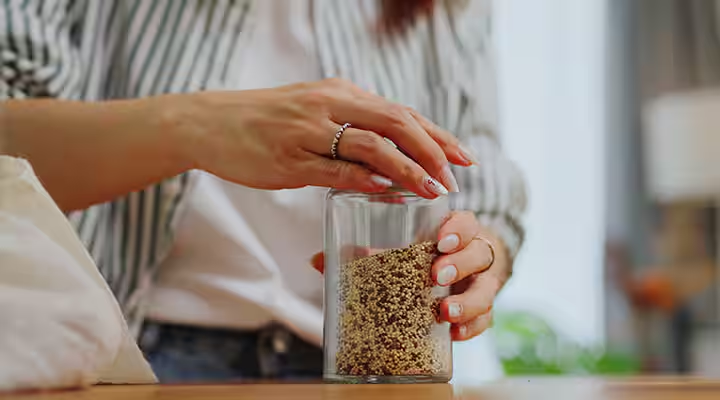Mast Cell Activation Syndrome (MCAS) is a complex, often misunderstood condition that can make everyday choices, like what to eat, feel overwhelming. In people with MCAS, mast cells (a type of immune cell) release chemicals like histamine in response to various triggers, leading to a wide range of symptoms such as hives, headaches, fatigue, digestive issues, and even anaphylaxis. One of the most common and challenging triggers? Food.
Certain foods can cause mast cells to overreact, either by containing high levels of histamine, triggering histamine release, or interfering with how the body breaks histamine down. Unfortunately, there’s no universal list of “safe” or “unsafe” foods for everyone with MCAS, but understanding common culprits can make it easier to manage symptoms and reduce flare-ups.
Recommended: Can I Take Creatine And Pre-Workout?
In this post, we’ll explore the types of foods that often aggravate MCAS symptoms, why they’re problematic, and how to approach your diet in a more informed, supportive way.
What is Mast Cell Activation Syndrome (MCAS)?

Mast Cell Activation Syndrome (MCAS) is a condition in which the body’s mast cells, which are important parts of the immune system, release chemicals too frequently or inappropriately. Normally, mast cells help protect the body from threats like infections or allergens. In MCAS, these cells become overly sensitive and can release substances such as histamine and other inflammatory compounds even without a clear trigger.
Recommended: Why Do I Have More Fat Under One Armpit?
Because mast cells are found in nearly every tissue in the body, the symptoms of MCAS can be wide-ranging and affect multiple systems. Common symptoms include skin reactions like hives and flushing, digestive issues such as bloating and diarrhea, respiratory problems, and neurological symptoms like brain fog or anxiety. This variability often makes MCAS difficult to recognize and diagnose, since it can mimic many other conditions.
One of the most challenging aspects of living with MCAS is identifying and managing personal triggers. These can include environmental factors, medications, stress, and certain foods. Dietary triggers may either contain high levels of histamine or cause mast cells to release histamine, leading to symptom flare-ups. For many people with MCAS, adjusting the diet becomes a key part of symptom management and improving overall quality of life.
Why is a Balanced Diet Important if You Have Mast Cell Activation Syndrome?
Histamine is a chemical produced by mast cells in the body, but it’s also naturally present in many foods. Some foods contain high levels of histamine, which can directly trigger symptoms in people with Mast Cell Activation Syndrome (MCAS). Others may not be high in histamine but can stimulate the body to release it, also leading to symptom flare-ups. While these foods are generally well-tolerated by people without MCAS, those with the condition often need to be more mindful of their intake to help manage symptoms.
Although histamine from food and histamine released by mast cells are chemically the same, they affect the body differently. The body relies on enzymes—particularly diamine oxidase (DAO)—to break down excess histamine. If these enzymes are not functioning properly or are overwhelmed, histamine can accumulate and worsen symptoms. For individuals with MCAS, consuming histamine-rich foods may add to the total histamine load, making symptoms more difficult to control. While it’s not possible to completely eliminate histamines from the diet, reducing high-histamine foods can be a helpful strategy for symptom management. Working with a registered dietitian can help you tailor a plan that lowers histamine exposure while still meeting your nutritional needs.
A registered dietitian nutritionist (RDN) may suggest following a low-histamine diet for about 2 to 6 weeks, followed by a gradual reintroduction of higher-histamine foods. If symptoms noticeably improve during the elimination phase and return upon reintroduction, histamine intolerance could be a contributing factor. On the other hand, if symptoms don’t change significantly, histamine may not be a major trigger for you. Since elimination diets can be restrictive, it’s important to work with a healthcare provider to ensure you’re following the process safely and to help identify other potential MCAS triggers if histamine doesn’t appear to be the issue.
Recommended: Does Eating Too Much Bread Cause Yeast Infection?
How Diet Affects MCAS Symptoms
For people with Mast Cell Activation Syndrome (MCAS), diet can have a major impact on symptom management. Certain foods may trigger or worsen symptoms by influencing how mast cells behave or how the body processes histamine. Here are some of the main ways diet can affect MCAS:
Foods High in Histamine Can Worsen Symptoms
Some foods naturally contain high levels of histamine. When consumed, they can overwhelm the body’s ability to process histamine and lead to increased symptoms. Common high-histamine foods include aged cheeses, smoked or cured meats, fermented products, vinegar, and alcohol.
Certain Foods Can Trigger Histamine Release
Even if a food doesn’t contain much histamine, it can still cause mast cells to release histamine and other inflammatory chemicals. These histamine-releasing foods often include citrus fruits, tomatoes, strawberries, chocolate, and shellfish.
Some Foods Inhibit Histamine Breakdown

The body uses an enzyme called diamine oxidase (DAO) to break down histamine. Some foods and substances can block or reduce DAO activity, making it harder to clear histamine from the system. This includes alcohol, energy drinks, and some teas or medications.
Food Additives and Preservatives May Act as Triggers
Many processed foods contain additives, colorings, and preservatives that can activate mast cells or interfere with histamine metabolism. Common culprits include artificial dyes, MSG, sulfites, and benzoates.
Because every person with MCAS reacts differently, it’s important to track individual food responses. Keeping a food and symptom diary, working with a healthcare provider, or following an elimination or low-histamine diet can be helpful in identifying specific dietary triggers.
Recommended: How to Boost Gut Health Naturally
Foods to Avoid with Mast Cell Activation Syndrome
Managing Mast Cell Activation Syndrome (MCAS) often requires careful attention to your diet. Certain foods can either contain high amounts of histamine, trigger mast cell degranulation, or interfere with the body’s ability to process histamine. While individual triggers can vary, the following categories of foods are commonly avoided by people with MCAS:
1. High-Histamine Foods
These foods naturally contain high levels of histamine and are often the first to be eliminated on a low-histamine diet:
- Aged cheeses (parmesan, cheddar, blue cheese)
- Cured or smoked meats (salami, bacon, pepperoni)
- Fermented foods (sauerkraut, kimchi, yogurt, kombucha)
- Alcohol (especially red wine, beer, and champagne)
- Vinegar and vinegar-containing products (pickles, mustard)
- Canned or processed fish (tuna, sardines, mackerel)
2. Histamine-Releasing Foods
These foods may not contain histamine themselves but can stimulate the body’s mast cells to release histamine:
- Citrus fruits (oranges, lemons, limes, grapefruits)
- Strawberries
- Tomatoes and tomato-based products
- Chocolate
- Shellfish
- Nuts (especially walnuts, cashews, and peanuts)
- Egg whites
3. Foods That Block DAO (Histamine-Degrading Enzyme)
Some foods reduce the activity of diamine oxidase (DAO), the enzyme responsible for breaking down histamine:
- Alcohol
- Black tea, green tea, and energy drinks
- Certain medications and supplements (some painkillers, antibiotics, antidepressants)
Recommended: Can SIBO Cause Weight Gain?
4. Leftovers and Aged or Stored Foods
Histamine levels increase as food sits, so even low-histamine foods can become problematic over time:
- Leftovers stored for more than 24 hours
- Slow-cooked or reheated meals
- Prepackaged or convenience foods
5. Processed and Packaged Foods with Additives
Artificial additives, preservatives, and flavor enhancers can act as mast cell triggers:
- Monosodium glutamate (MSG)
- Food dyes and colorings (like Red 40 or Yellow 5)
- Sulfites (commonly found in dried fruits and wine)
- Benzoates and nitrates
Long-Term Effects of Ignoring Food Triggers in MCAS
For individuals with Mast Cell Activation Syndrome (MCAS), consistently ignoring food triggers can lead to a gradual worsening of symptoms and overall health. While occasional exposures may result in mild discomfort, repeated or prolonged exposure to problematic foods can overwhelm the body’s ability to regulate inflammation and histamine levels. Over time, this may contribute to chronic, debilitating symptoms that affect multiple systems in the body.
1. Worsening of Systemic Inflammation
Persistent exposure to food triggers can lead to chronic activation of mast cells. This ongoing immune activation may result in widespread inflammation throughout the body, contributing to conditions such as chronic fatigue, joint pain, headaches, gastrointestinal issues, and skin flare-ups like rashes or hives.
2. Increased Frequency and Severity of Flare-Ups

Ignoring food-related triggers may lower your mast cell threshold over time. This means that your body can begin reacting to smaller amounts of histamine or previously tolerated foods. Flare-ups may become more frequent, last longer, and require more aggressive treatment to control.
Recommended: How to Increase Sodium Levels in Your Blood?
3. Development of Secondary Conditions
Chronic inflammation and ongoing mast cell activation can increase the risk of developing other health issues, such as irritable bowel syndrome (IBS), leaky gut, histamine intolerance, or even autoimmune-like symptoms. The immune system becomes more dysregulated, making it harder to manage existing symptoms or respond appropriately to new triggers.
4. Reduced Quality of Life
Persistent symptoms like fatigue, brain fog, abdominal discomfort, anxiety, or skin irritation can significantly impact daily functioning. Over time, unmanaged MCAS can interfere with work, relationships, mental health, and sleep, contributing to emotional exhaustion and reduced quality of life.
5. Increased Dependence on Medication
Without dietary adjustments, some individuals may find themselves relying more heavily on antihistamines, corticosteroids, or other symptom-management drugs. While these medications can be helpful, they often come with side effects and may not be a sustainable solution for long-term health.
Conclusion
Mast Cell Activation Syndrome can be challenging to manage, especially when it comes to identifying and avoiding dietary triggers. However, understanding how certain foods affect mast cell behavior is an important part of reducing symptoms and improving day-to-day health. While everyone’s triggers may differ, being aware of common problem foods is a helpful starting point.
Making informed food choices, staying consistent, and paying attention to your body’s signals can lead to meaningful improvements over time. With the right knowledge and support, it’s possible to take control of your symptoms and feel more confident in managing MCAS through diet and lifestyle.

[…] Recommended: Foods to Avoid with Mast Cell Activation Syndrome (MCAS) […]
[…] Recommended: Foods to Avoid with Mast Cell Activation Syndrome (MCAS) […]
[…] Recommended: Foods to Avoid with Mast Cell Activation Syndrome (MCAS) […]